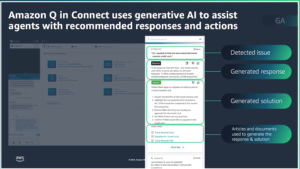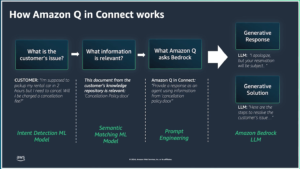Back in December 2023, we took note of the introduction of Amazon Q, a GenAI-based employee assistant, and we wondered how it would be put to use for customer assistance in contact centers. During a recent demonstration at Amazon’s Contact Center Day, Amazon spokespeople showcased how Amazon Q integrates with Amazon Connect to empower agents with real-time support during customer interactions.
Intelligent Assistance in Real-Time
Amazon Q aims to enhance the traditional agent workspace with dynamic, GenAI-driven capabilities. As customer interactions unfold, Q actively analyzes the conversation in real-time. Its primary function is to detect the customer’s intent accurately. This initial step is crucial as it informs the subsequent actions of the assistant.
With the customer’s intent identified, Amazon Q looks for relevant knowledge sources. It selects information that is most relevant to the ongoing conversation. This enables Q to suggest precise and contextual responses to the agent that are tailored based on the specific details and needs expressed by the customer.
 Step-by-Step Guidance
Step-by-Step Guidance
Beyond offering suggested responses, Amazon Q provides agents with scripted step-by-step guides. These guides outline the actions necessary to resolve the customer’s request efficiently. This feature is especially beneficial for new agents who may require additional guidance.
Transparency and Insight
One of the innovative aspects of Amazon Q is its transparency in operations. The AI system provides insights into the knowledge sources it uses to generate its recommendations. This feature not only builds trust among agents but also helps them understand the rationale behind specific suggestions, fostering a learning environment within the workspace.
Configuration Steps Required to Enable Amazon Q in Connect
Setting up Amazon Q to provide AI-powered assistance requires integrating the system with various knowledge sources to build a comprehensive knowledge base. The key steps involve enabling Amazon Q in the Connect console, connecting data sources like S3, SharePoint, Salesforce, ServiceNow, and Zendesk, encrypting content with AWS KMS keys, configuring contact flows to assign permissions and sync frequencies, and establishing processes for regular knowledge base maintenance and updates.
However, simply integrating data sources is not enough. Organizations must also optimize their knowledge sources to make the information more usable by the AI system. This includes steps like converting documents to plain text, removing redundant content, using consistent terminology, and structuring data clearly. Careful curation of the knowledge base is critical for Amazon Q to provide accurate and relevant assistance.
In summary, deploying Amazon Q is a multi-faceted process requiring integration of knowledge sources, security setup, workflow configuration, and ongoing knowledge base management tuned specifically for an AI system. Proper implementation lays the groundwork for Amazon Q to effectively augment contact center operations.
 How Amazon Q Operates Under-the-Covers
How Amazon Q Operates Under-the-Covers
Amazon Q in Connect leverages a series of advanced machine learning models to enhance the customer support experience through real-time AI assistance. The process begins with an Intent Detection ML Model, which analyzes the customer’s inquiry to determine the underlying intent. Once the intent is identified, a Semantic Matching ML Model is engaged to sift through the connected knowledge base, identifying the most relevant documents or information that address the customer’s specific issue.
This information is used to construct a response and solution, which are generated through a combination of Prompt Engineering and natural language generation technologies, ensuring that the responses are not only accurate but also contextually appropriate. The prompts are executed on the Amazon Bedrock platform, which provides the flexibility of selecting from a variety of language models as we discussed in our earlier article.
Amazon Q’s technology stack appears to be largely proprietary, which comes with pros and cons. The pros include the fact that the ML models are most likely highly customized for optimal performance within Amazon’s services. Handling many aspects of the technology in-house can lead to better security and compliance management.
As for the cons, customers might become dependent on Amazon’s technology and infrastructure, which can limit flexibility and increase long-term costs.
Precise Information Generated by an Always There Mentor
The introduction of Amazon Q as an assistant for contact center agents highlights the transformative potential of AI in enhancing customer support operations. Particularly for less experienced agents, Amazon Q acts like a vigilant mentor, always available to guide through every customer interaction. This AI assistant swiftly understands customer needs, suggesting appropriate responses and offering reliable advice on resolving issues, which can indeed feel like a magical augmentation of an agent’s capabilities.
However, it’s crucial for organizations to recognize the investment required in setting up and maintaining this system. The effectiveness of Amazon Q heavily depends on the quality and extent of the knowledge sources integrated into the system. Organizations must commit to the continuous creation, curation, and connection of these resources to fully leverage the AI’s capabilities.
As for the performance of the various machine learning models used by Amazon Q, the true measure of their effectiveness will come from the agents and customers who interact with them daily.
Categories: Intelligent Assistants, Articles

 NiCE Interactions 2025: Agentic AI, Better Data, and a Whole Lot of Partnership
NiCE Interactions 2025: Agentic AI, Better Data, and a Whole Lot of Partnership  Getting It Right: What AI Agents Actually Mean for Customer Support (Webinar)
Getting It Right: What AI Agents Actually Mean for Customer Support (Webinar)  Beyond the Basics: How AI Is Transforming B2B Sales at TP
Beyond the Basics: How AI Is Transforming B2B Sales at TP  Five9 Launches Agentic CX: Toward AI Agents That Reason and Act
Five9 Launches Agentic CX: Toward AI Agents That Reason and Act